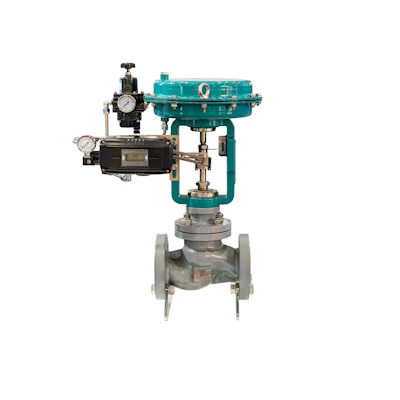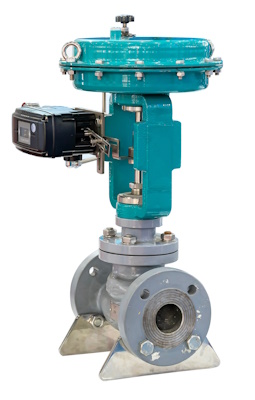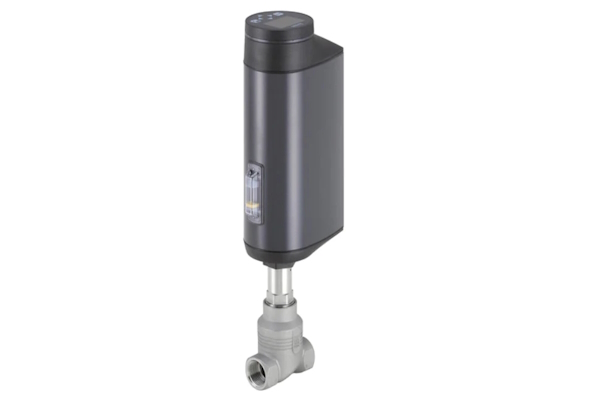Maintenance and Troubleshooting of Actuated Globe Valves

Figure 1: Actuated globe valve
Regular maintenance is vital for maximizing the lifespan and performance of actuated globe valves. To achieve this, it is crucial to understand the complexities in their design, common issues that may arise, and the best practices for addressing these challenges. This article explores the best maintenance practices for pneumatic and electric globe valves.
View our online selection of globe valves!
Pneumatic globe valve maintenance

Figure 2: Pneumatic globe valve
A globe valve with a pneumatic actuator utilizes air pressure to control the valve's opening and closing mechanisms.
Understanding pneumatic actuation
- Air supply quality: Ensure the air supply to the pneumatic actuator is clean and dry. Moisture and particulate matter in the air supply can cause internal corrosion and clogging of pneumatic components. Installing air filters and dryers in the pneumatic supply line is crucial.
- Air pressure regulation: Regularly check and calibrate air pressure regulators. Pneumatic globe valves rely on precise air pressure to operate effectively. Incorrect air pressure can lead to improper valve positioning, affecting flow control and potentially causing valve and actuator damage. Air supply inspection can be done on a monthly basis.
- Actuator diaphragm integrity: Inspect the diaphragm for wear, elasticity loss, or tears. A compromised diaphragm can lead to actuator failure, resulting in valve malfunction. Replace the diaphragm if it is worn out.
- Solenoid valve functionality: Solenoid valves often control the air flow to the actuator. Test the solenoid operation for swift and accurate response to control signals. Clean the solenoid ports and replace solenoid coils that show signs of overheating or electrical failure. This can be done at scheduled maintenance intervals or if operational issues arise.
Maintenance and repair practices
The following practices can be performed regularly on a weekly basis:
- Air leak detection: Periodically inspect all pneumatic connections, fittings, and tubing for air leaks using a soap solution or an ultrasonic leak detector. Even minor leaks can lead to significant loss of efficiency and control accuracy. Ensure tight connections and replace any worn tubing or seals.
- Lubrication: While the internal components of the actuator may require less lubrication than mechanical parts, ensure that any moving parts within the actuator, such as springs or pistons, are lightly lubricated with a suitable, manufacturer-recommended lubricant. This is particularly important in harsh environments where contaminants may enter the actuator housing.
- Stem and packing: For pneumatic globe valves, the stem movement is more frequent and dynamic. Use specialized packing material that can withstand the dynamic movement and pressure fluctuations without degrading. Regularly adjust the packing gland nuts to ensure a tight seal while allowing smooth stem movement.
Advanced considerations
- Position feedback devices: Many pneumatic actuated globe valves are equipped with position feedback devices for more accurate control. Regularly inspect and test these devices to ensure they accurately reflect valve position. Misalignment or failure can lead to incorrect valve operation, affecting the entire control loop.
- Preventive replacement of wear parts: Identify and replace wear-prone components, such as o-rings, seals, and the actuator diaphragm, before they fail. This preemptive approach can prevent unexpected downtime and maintain optimal valve performance.
- Environmental protection: If the pneumatic globe valve is located in an environment prone to dust, moisture, or corrosive gasses, consider installing protective covers or shields. This can prevent premature wear of pneumatic components and extend the valve's service life.
Electric actuated globe valve maintenance and repair

Figure 3: Electric globe valve
Globe valves with electric actuators rely on electrical power to drive the actuator for opening or closing the valve.
Understanding electric actuation
- Electrical connections and wiring: Regularly inspect electrical connections and wiring for signs of wear, corrosion, or damage. Loose or corroded connections can lead to intermittent operation or complete failure of the valve actuator. Ensure that all wiring is properly secured and protected from environmental factors.
- Actuator motor health: The health of the electric motor in the actuator is paramount. Monitor motor current and temperature to identify signs of overload or impending failure. Use thermal imaging or motor testing equipment to assess the condition of the motor and preemptively address issues.
- Limit switches and position indicators: Electric globe valves often use limit switches to signal the open or closed position and may have position indicators for more precise control. Test these components regularly (quarterly or biannually) to ensure they accurately reflect the valve's position and function correctly within the control system.
Maintenance and repair practices
- Voltage and power supply consistency: Ensure that the voltage supply to the electric actuator matches the manufacturer's specifications. Fluctuations in power supply can lead to erratic valve behavior or damage to the actuator's electrical components. Consider installing power conditioning equipment if supply stability is an issue. This could be a continuous process with alerts for deviations.
- Control system integration: Verify the integration and communication between the electric globe valve actuator and the control system. Miscommunication or signal interference can lead to incorrect valve positioning, affecting process control. Regularly update and backup control system software to prevent compatibility issues.
- Surge protection: Implement surge protection measures to protect the electric actuator and its components from voltage spikes. This is particularly important in areas prone to lightning or where power supply issues are common.
- Heat management: Electric motors can generate heat, particularly during extended operation cycles. Ensure proper ventilation around the valve to prevent overheating and potential motor damage.
- Valve stem and actuator gear alignment: Check the alignment between the valve stem and the actuator gearing. Misalignment can cause uneven wear and tear on the actuator and valve stem, leading to operational inefficiencies and potential failure. This could be done annually or biannually.
- Lubrication of moving parts: While electric actuators generally require less frequent lubrication than pneumatic actuators, it's important to lubricate the valve stem and any accessible moving parts within the actuator according to the manufacturer's recommendations. Use lubricants suitable for the operating environment to prevent contamination.
- Seal and packing inspection: Inspect the seals and packing around the valve stem for signs of leakage or wear. Electric globe valves may experience different operational cycles compared to pneumatic valves, affecting the wear patterns on these components. Replace seals and packing as needed to ensure tight sealing and prevent fluid leakage.
Advanced considerations
- Diagnostic and predictive maintenance tools: Utilize diagnostic tools and software provided by the valve or actuator manufacturer to monitor valve performance and predict maintenance needs. Many modern electric actuators include built-in diagnostics that can alert operators to potential issues before they lead to failure.
- Environmental considerations: Protect electric globe valves and actuators from harsh environmental conditions by ensuring that enclosures and protective covers are intact and properly sealed. Consider additional protective measures in extreme conditions, such as high humidity, corrosive atmospheres, or extreme temperatures.
- Professional calibration and testing: Periodically, have the valve and actuator professionally calibrated and tested to ensure optimal performance. This includes verifying the accuracy of control signals, the responsiveness of the actuator, and the integrity of mechanical components. This can be done typically every 1-2 years depending on the criticality of the application.




